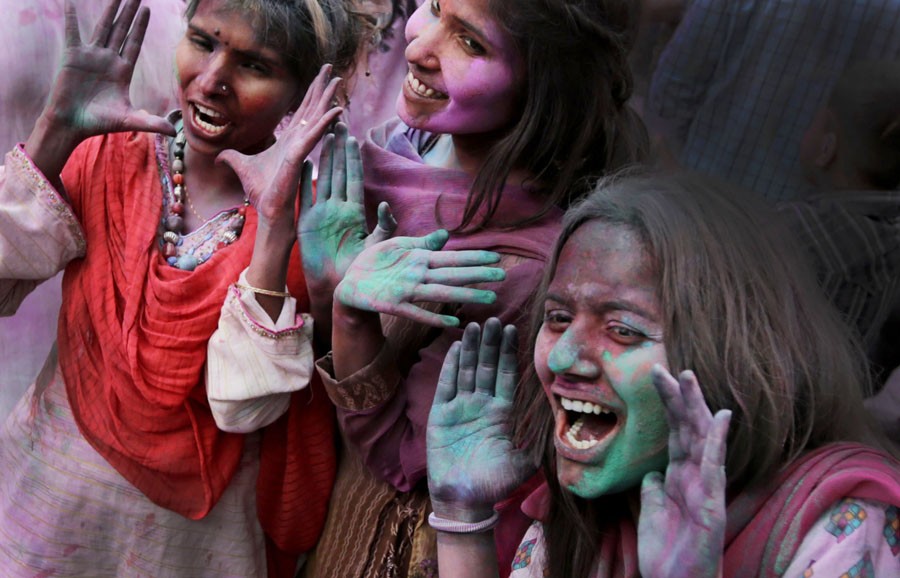

Holi was not celebrated but rather curated in Lahore this week, at Lahore’s Krishna temple, located in a tiny street near Minar-e-Pakistan, just off the Ravi Road, was decorated with lights.
Dozens of people, mostly from religious minorities, gathered there, probably the only public space where the festival was officially observed. On festive occasions like Diwali and Holi, the street is blocked with tents and the temple becomes the venue for celebration. The usual tents, lights, and food tables that we see at a wedding are present there.
Previously, the Valmiki temple in Anarkali, which is often hailed as the oldest functional temple of Lahore, used to celebrate Holi. One of the advantages of the place was that it has its own courtyard, where celebrations would take place behind the peace and privacy of four walls. However, last year on Diwali and now on Holi too, the custodian of the Valmiki Mandir apologised that there could be no festivity due to a death in the family. On both the occasions he guided people to the Krishna Temple -- a lesser known but equally active establishment which is much further away, almost on the bank of the Ravi. The traffic is often chocked by frightening trucks due to cross the river.
If you had entered the Krishna Mandir from the Ravi Rd, the tents were blocking the entire street which was in turn blocked by the police personnel and vehicles. This time, however, they didn’t ask us for an ID card and were busy having tea with mithai (sweets).
On the left of the tents is a plot that had the food tables and about a dozen youngsters already soaked in colours. They were all busy taking selfies and making videos. Many children were there too, not dressed up but cheerful nevertheless. Most of them were excited about the sweets that were about to be distributed as prasad (offering to gods).
One crosses the tent, busy TV reporters, and on the left hand again is the door that leads to the temple. And like most temples in Pakistan, the murtis (the statues of goddesses) are kept in a corner or usually a separate room. Therefore, when you enter the temple, you see the main white wall covered with banners that say, "Happy Holi" in Hindi and carries photos of the Board Secretary Muhammad Tariq.
Tariq also talked to the media on the occasion, and said, "We won’t ever let the minorities feel like they are a minority in Pakistan." That statement was well-intentioned indeed but is there any religious minority in Pakistan which isn’t acutely aware of the fact that it is a religious minority?
Inside the temple, they were reciting bhajan in a Punjabi accent and with dholki. Camera surrounded the little quarter where the pooja (worship of gods) was taking place. Chants of "Hare Rama," and "Shankar Bhagwaan aur Lakshmi Narayan ki Jai" filled the air, along with the scent of agarbatti. Most of the devotees here were male because most of the women were uncomfortable with cameras.
The ceremony, the only one taking place in a town that was once one-third Hindu, has a symbolic value. The journalists know it and therefore the temple usually has as many cameras on festivals as devotees. The steel pooja thali (plate for worship) followed half a dozen, tiny diyaas (oil lamps) on it that the worshippers encircled with their hands.
In the main tent, there was a stage that was decorated with plastic white flowers and bright yellow stage lights that gave the otherwise white tent a dreamy hue. But the anti-climax was the microphone, which was incredibly loud and some of the things being said on it were the mundane greetings, messages of gratitude and patriotism. A woman in white, who sat there in the centre of the stage with the chief guest, Muhammad Tariq, was smiling and listening intently. Later, her name was announced -- she was Jahanara Watto, the daughter of former Chief Minister of Punjab Manzoor Watto, and now an active member of the Pakistan People’s Party herself.
On the stage, first the gratitude list and then re-affirming-your-patriotism speech took place, complete with the song, "Iss parcham ke saye tale hum eik hain" (under the shadow of this flag we are one). Kiran, a fair singer, sang a bhajan, "Satyam, shivam, sundaram." On popular demand, this was followed by a Madam Noor Jehan’s Punjabi number, "Mere dil de sheeshay wich sajna".
The sound system kept betraying her but Kiran continued to sing in her melodious and girl-like voice. Eventually, some people on the stage sang a bhajan, "Na koi tera na koi mera" with dholki.
The bhajan had verses about the frivolity of the material world and the significance of finding oneself -- notions that have a universal appeal.
"Bahar ki tu maati phanke, mann ke bheetar kyun na jhanke?" (You search the mud outside but why don’t you sneak into your own mind?)
Mithai and cake in orange boxes from local bakeries were now being circulated as prasad, along with a white coloured hot drink that I presume was kawah (tea).
Though some people had colour on their faces, there was very little coloured power left and some of us had to request the guests on the stage to pass on their colour platters so that we could have a few moments of Holi too. This running out of colour seemed symbolic of the Holi celebration in Lahore that day -- everything was present but the actual festivity that everyone had congregated for. Hopefully, the youngsters and children who seemed cheerful and engrossed in this revelry will grow up and seek a more genuine Holi instead of this pre-planned and administered event under the media glare.